NURS2003 Pathophysiology: Analyzing Stroke in Greta Balodis Case
VerifiedAdded on 2023/06/12
|10
|2564
|78
Case Study
AI Summary
This case study examines the pathophysiology of stroke through the scenario of Greta Balodis, a 75-year-old widow who experiences stroke symptoms. It delves into the causes of stroke, including hemorrhagic and ischemic types, and relates them to Greta's medical history of hypertension, Cerebral Vascular Accident, and arterial fibrillation. The study further explains the signs and symptoms of stroke, such as face and leg numbness, paralysis, headache, nausea, and dizziness, connecting them to the underlying pathophysiology. The F.A.S.T method for stroke detection is also discussed. The case study concludes that Greta Balodis is suffering from stroke based on her symptoms and medical history, emphasizing the importance of understanding stroke pathophysiology for effective diagnosis and management. Desklib provides access to similar case studies and resources for students.
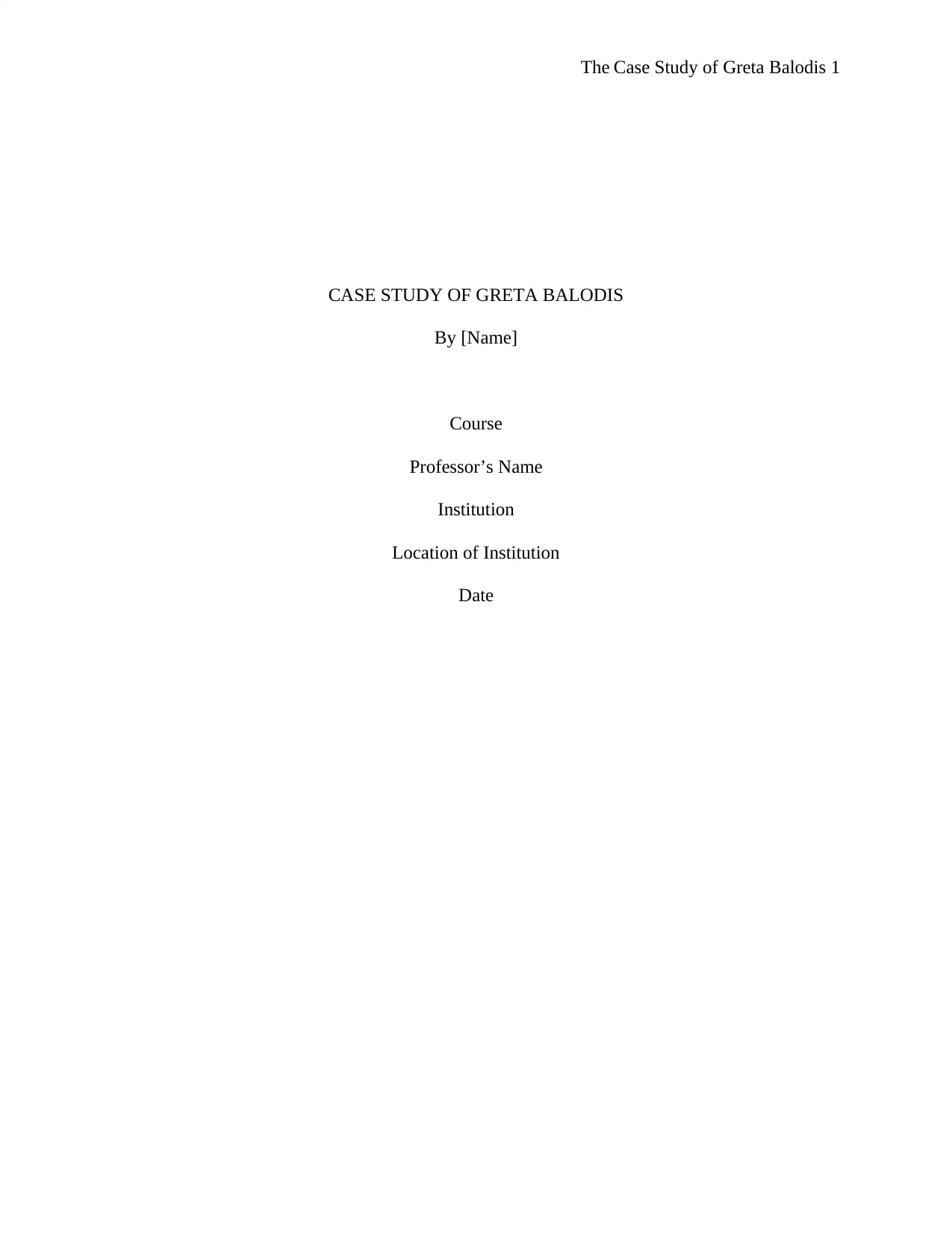
The Case Study of Greta Balodis 1
CASE STUDY OF GRETA BALODIS
By [Name]
Course
Professor’s Name
Institution
Location of Institution
Date
CASE STUDY OF GRETA BALODIS
By [Name]
Course
Professor’s Name
Institution
Location of Institution
Date
Paraphrase This Document
Need a fresh take? Get an instant paraphrase of this document with our AI Paraphraser
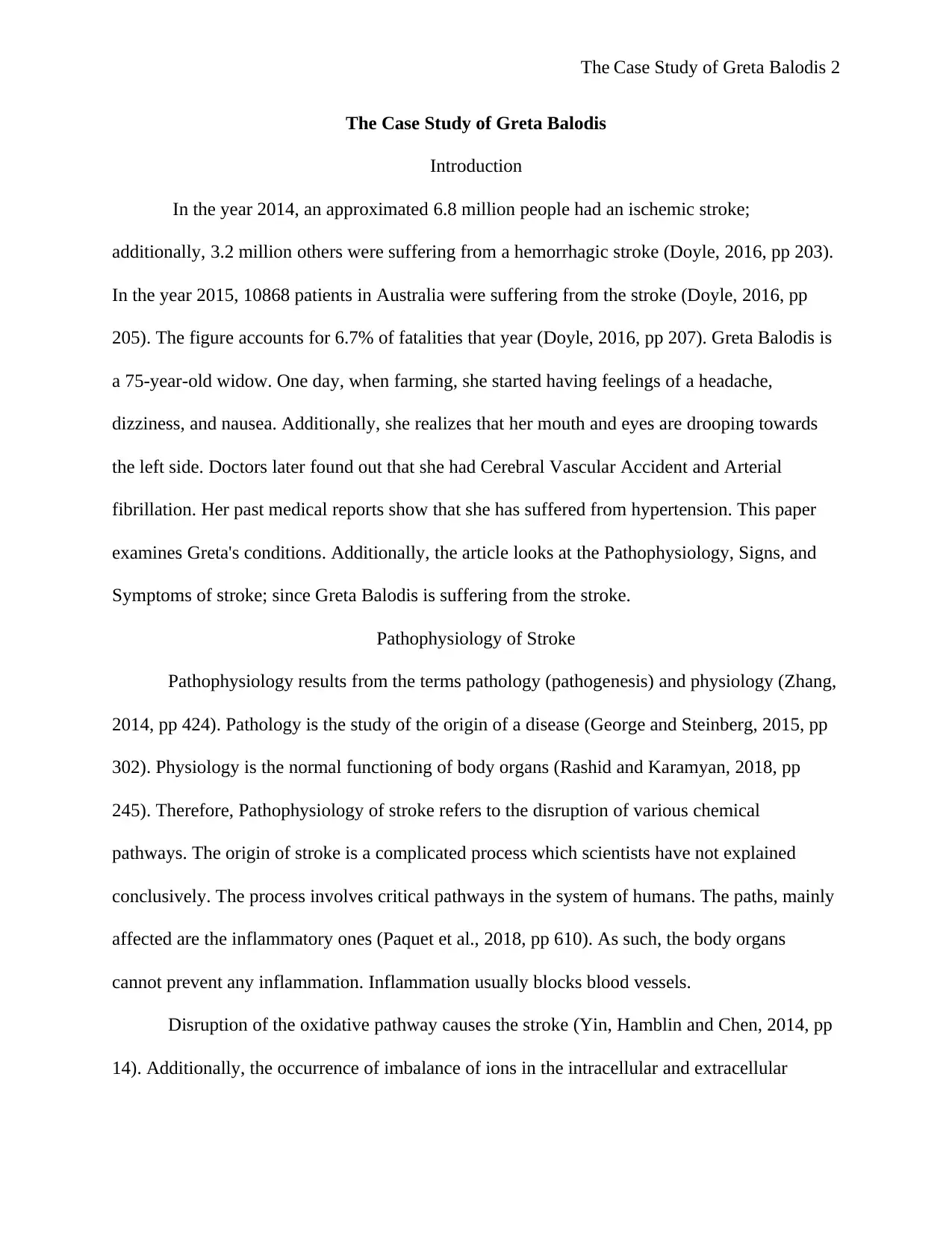
The Case Study of Greta Balodis 2
The Case Study of Greta Balodis
Introduction
In the year 2014, an approximated 6.8 million people had an ischemic stroke;
additionally, 3.2 million others were suffering from a hemorrhagic stroke (Doyle, 2016, pp 203).
In the year 2015, 10868 patients in Australia were suffering from the stroke (Doyle, 2016, pp
205). The figure accounts for 6.7% of fatalities that year (Doyle, 2016, pp 207). Greta Balodis is
a 75-year-old widow. One day, when farming, she started having feelings of a headache,
dizziness, and nausea. Additionally, she realizes that her mouth and eyes are drooping towards
the left side. Doctors later found out that she had Cerebral Vascular Accident and Arterial
fibrillation. Her past medical reports show that she has suffered from hypertension. This paper
examines Greta's conditions. Additionally, the article looks at the Pathophysiology, Signs, and
Symptoms of stroke; since Greta Balodis is suffering from the stroke.
Pathophysiology of Stroke
Pathophysiology results from the terms pathology (pathogenesis) and physiology (Zhang,
2014, pp 424). Pathology is the study of the origin of a disease (George and Steinberg, 2015, pp
302). Physiology is the normal functioning of body organs (Rashid and Karamyan, 2018, pp
245). Therefore, Pathophysiology of stroke refers to the disruption of various chemical
pathways. The origin of stroke is a complicated process which scientists have not explained
conclusively. The process involves critical pathways in the system of humans. The paths, mainly
affected are the inflammatory ones (Paquet et al., 2018, pp 610). As such, the body organs
cannot prevent any inflammation. Inflammation usually blocks blood vessels.
Disruption of the oxidative pathway causes the stroke (Yin, Hamblin and Chen, 2014, pp
14). Additionally, the occurrence of imbalance of ions in the intracellular and extracellular
The Case Study of Greta Balodis
Introduction
In the year 2014, an approximated 6.8 million people had an ischemic stroke;
additionally, 3.2 million others were suffering from a hemorrhagic stroke (Doyle, 2016, pp 203).
In the year 2015, 10868 patients in Australia were suffering from the stroke (Doyle, 2016, pp
205). The figure accounts for 6.7% of fatalities that year (Doyle, 2016, pp 207). Greta Balodis is
a 75-year-old widow. One day, when farming, she started having feelings of a headache,
dizziness, and nausea. Additionally, she realizes that her mouth and eyes are drooping towards
the left side. Doctors later found out that she had Cerebral Vascular Accident and Arterial
fibrillation. Her past medical reports show that she has suffered from hypertension. This paper
examines Greta's conditions. Additionally, the article looks at the Pathophysiology, Signs, and
Symptoms of stroke; since Greta Balodis is suffering from the stroke.
Pathophysiology of Stroke
Pathophysiology results from the terms pathology (pathogenesis) and physiology (Zhang,
2014, pp 424). Pathology is the study of the origin of a disease (George and Steinberg, 2015, pp
302). Physiology is the normal functioning of body organs (Rashid and Karamyan, 2018, pp
245). Therefore, Pathophysiology of stroke refers to the disruption of various chemical
pathways. The origin of stroke is a complicated process which scientists have not explained
conclusively. The process involves critical pathways in the system of humans. The paths, mainly
affected are the inflammatory ones (Paquet et al., 2018, pp 610). As such, the body organs
cannot prevent any inflammation. Inflammation usually blocks blood vessels.
Disruption of the oxidative pathway causes the stroke (Yin, Hamblin and Chen, 2014, pp
14). Additionally, the occurrence of imbalance of ions in the intracellular and extracellular
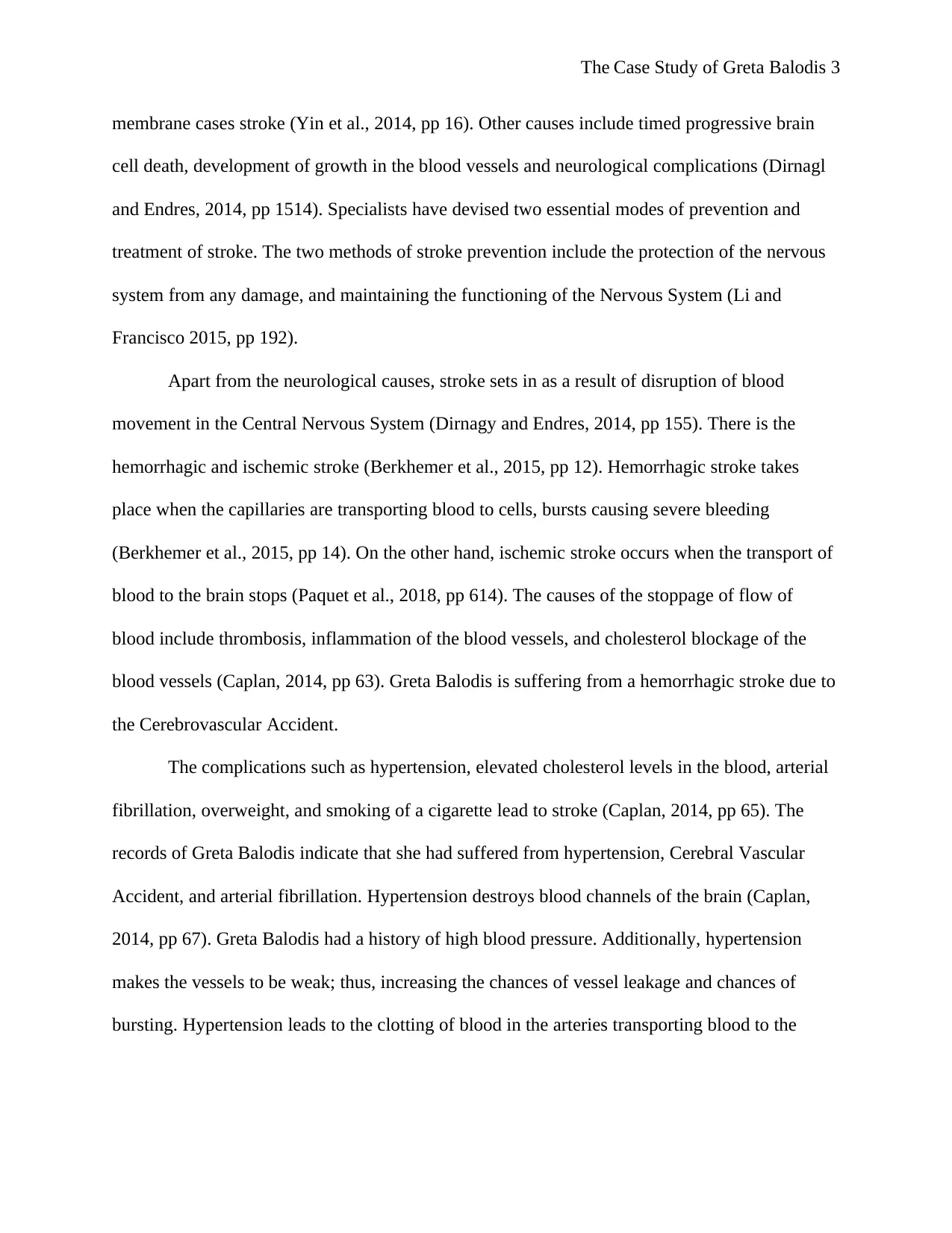
The Case Study of Greta Balodis 3
membrane cases stroke (Yin et al., 2014, pp 16). Other causes include timed progressive brain
cell death, development of growth in the blood vessels and neurological complications (Dirnagl
and Endres, 2014, pp 1514). Specialists have devised two essential modes of prevention and
treatment of stroke. The two methods of stroke prevention include the protection of the nervous
system from any damage, and maintaining the functioning of the Nervous System (Li and
Francisco 2015, pp 192).
Apart from the neurological causes, stroke sets in as a result of disruption of blood
movement in the Central Nervous System (Dirnagy and Endres, 2014, pp 155). There is the
hemorrhagic and ischemic stroke (Berkhemer et al., 2015, pp 12). Hemorrhagic stroke takes
place when the capillaries are transporting blood to cells, bursts causing severe bleeding
(Berkhemer et al., 2015, pp 14). On the other hand, ischemic stroke occurs when the transport of
blood to the brain stops (Paquet et al., 2018, pp 614). The causes of the stoppage of flow of
blood include thrombosis, inflammation of the blood vessels, and cholesterol blockage of the
blood vessels (Caplan, 2014, pp 63). Greta Balodis is suffering from a hemorrhagic stroke due to
the Cerebrovascular Accident.
The complications such as hypertension, elevated cholesterol levels in the blood, arterial
fibrillation, overweight, and smoking of a cigarette lead to stroke (Caplan, 2014, pp 65). The
records of Greta Balodis indicate that she had suffered from hypertension, Cerebral Vascular
Accident, and arterial fibrillation. Hypertension destroys blood channels of the brain (Caplan,
2014, pp 67). Greta Balodis had a history of high blood pressure. Additionally, hypertension
makes the vessels to be weak; thus, increasing the chances of vessel leakage and chances of
bursting. Hypertension leads to the clotting of blood in the arteries transporting blood to the
membrane cases stroke (Yin et al., 2014, pp 16). Other causes include timed progressive brain
cell death, development of growth in the blood vessels and neurological complications (Dirnagl
and Endres, 2014, pp 1514). Specialists have devised two essential modes of prevention and
treatment of stroke. The two methods of stroke prevention include the protection of the nervous
system from any damage, and maintaining the functioning of the Nervous System (Li and
Francisco 2015, pp 192).
Apart from the neurological causes, stroke sets in as a result of disruption of blood
movement in the Central Nervous System (Dirnagy and Endres, 2014, pp 155). There is the
hemorrhagic and ischemic stroke (Berkhemer et al., 2015, pp 12). Hemorrhagic stroke takes
place when the capillaries are transporting blood to cells, bursts causing severe bleeding
(Berkhemer et al., 2015, pp 14). On the other hand, ischemic stroke occurs when the transport of
blood to the brain stops (Paquet et al., 2018, pp 614). The causes of the stoppage of flow of
blood include thrombosis, inflammation of the blood vessels, and cholesterol blockage of the
blood vessels (Caplan, 2014, pp 63). Greta Balodis is suffering from a hemorrhagic stroke due to
the Cerebrovascular Accident.
The complications such as hypertension, elevated cholesterol levels in the blood, arterial
fibrillation, overweight, and smoking of a cigarette lead to stroke (Caplan, 2014, pp 65). The
records of Greta Balodis indicate that she had suffered from hypertension, Cerebral Vascular
Accident, and arterial fibrillation. Hypertension destroys blood channels of the brain (Caplan,
2014, pp 67). Greta Balodis had a history of high blood pressure. Additionally, hypertension
makes the vessels to be weak; thus, increasing the chances of vessel leakage and chances of
bursting. Hypertension leads to the clotting of blood in the arteries transporting blood to the
⊘ This is a preview!⊘
Do you want full access?
Subscribe today to unlock all pages.

Trusted by 1+ million students worldwide

The Case Study of Greta Balodis 4
Central Nerves System (Caplan, 2014, pp 70). Blood clot blocks the movement of blood to the
brain cells leading to the onset of stroke.
Cerebral Vascular Accident (CVA) leads to the onset of Stroke. Greta Balodis had
suffered from CVA. The accidents can either be ischemic or hemorrhagic (Zhang, 2015, pp 425).
Ischemic stroke emanates from intravascular blood clotting (Vella et al., 2015, pp 108). Ischemic
stroke can either be thrombotic or embolic (Saver et al., 2015, pp 445). Thrombotic involves
clotting within the Bain cells.
The embolic stroke involves clotting of blood away from the central nervous System
(Saver et al., 2015, pp 448). The hemorrhagic stroke consists of the damage of brain blood
channels hence preventing blood flow to the brain (Doyle, 2016, pp 210). Arterial fibrillation
(A.F) is a heart defect which hampers the Arteriovascular muscles from pumping blood. Hence,
the blood remains stagnant in the vessels forming a clot. Therefore, A.F leads to ischemic stroke.
Arteriosclerosis is the narrowing of the circumference of the arteries due to the deposition of
substances such as Cholesterol (Zhang, 2015, pp 424). The condition blocks blood movement
leading to stroke.
Transient ischemic-stroke refers to the short-term hampering of blood flow to the brain
cells. Thus, the supplying of oxygen to provide to brain cells stops (Zhang, 2015, pp 426). The
mini attack leads to legs, arms and face weaknesses (Doyle, 2016, pp 208). Furthermore, vision
impediments and difficulty in speech sets in. The mini attack is not permanent as it can last for
forty-eight hours (Zhang, 2014, pp 425). Greta Balodis experiences a mini attack which causes
the stroke.
Signs and Symptoms of Stroke
The Face and Leg Numbness or Paralysis
Central Nerves System (Caplan, 2014, pp 70). Blood clot blocks the movement of blood to the
brain cells leading to the onset of stroke.
Cerebral Vascular Accident (CVA) leads to the onset of Stroke. Greta Balodis had
suffered from CVA. The accidents can either be ischemic or hemorrhagic (Zhang, 2015, pp 425).
Ischemic stroke emanates from intravascular blood clotting (Vella et al., 2015, pp 108). Ischemic
stroke can either be thrombotic or embolic (Saver et al., 2015, pp 445). Thrombotic involves
clotting within the Bain cells.
The embolic stroke involves clotting of blood away from the central nervous System
(Saver et al., 2015, pp 448). The hemorrhagic stroke consists of the damage of brain blood
channels hence preventing blood flow to the brain (Doyle, 2016, pp 210). Arterial fibrillation
(A.F) is a heart defect which hampers the Arteriovascular muscles from pumping blood. Hence,
the blood remains stagnant in the vessels forming a clot. Therefore, A.F leads to ischemic stroke.
Arteriosclerosis is the narrowing of the circumference of the arteries due to the deposition of
substances such as Cholesterol (Zhang, 2015, pp 424). The condition blocks blood movement
leading to stroke.
Transient ischemic-stroke refers to the short-term hampering of blood flow to the brain
cells. Thus, the supplying of oxygen to provide to brain cells stops (Zhang, 2015, pp 426). The
mini attack leads to legs, arms and face weaknesses (Doyle, 2016, pp 208). Furthermore, vision
impediments and difficulty in speech sets in. The mini attack is not permanent as it can last for
forty-eight hours (Zhang, 2014, pp 425). Greta Balodis experiences a mini attack which causes
the stroke.
Signs and Symptoms of Stroke
The Face and Leg Numbness or Paralysis
Paraphrase This Document
Need a fresh take? Get an instant paraphrase of this document with our AI Paraphraser
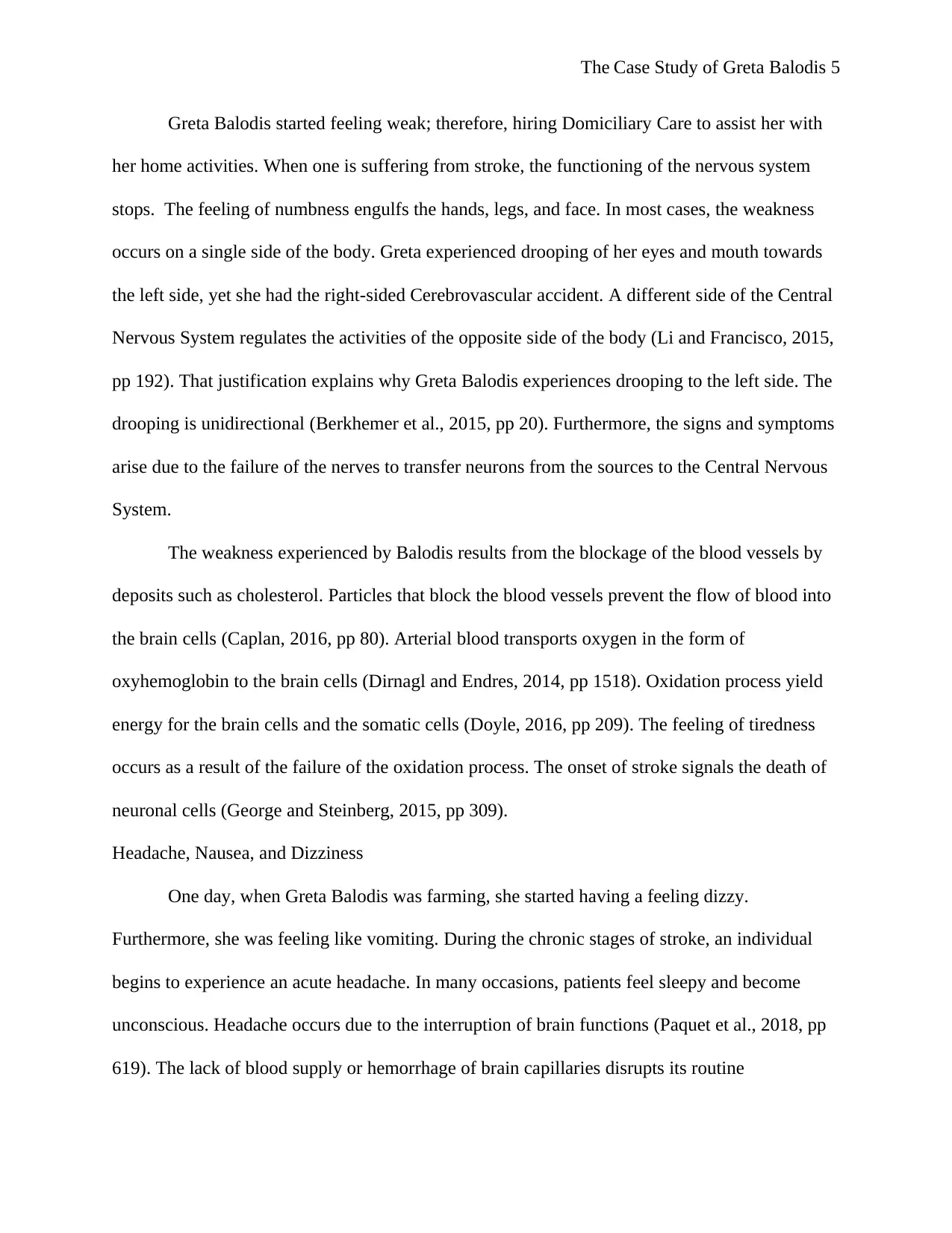
The Case Study of Greta Balodis 5
Greta Balodis started feeling weak; therefore, hiring Domiciliary Care to assist her with
her home activities. When one is suffering from stroke, the functioning of the nervous system
stops. The feeling of numbness engulfs the hands, legs, and face. In most cases, the weakness
occurs on a single side of the body. Greta experienced drooping of her eyes and mouth towards
the left side, yet she had the right-sided Cerebrovascular accident. A different side of the Central
Nervous System regulates the activities of the opposite side of the body (Li and Francisco, 2015,
pp 192). That justification explains why Greta Balodis experiences drooping to the left side. The
drooping is unidirectional (Berkhemer et al., 2015, pp 20). Furthermore, the signs and symptoms
arise due to the failure of the nerves to transfer neurons from the sources to the Central Nervous
System.
The weakness experienced by Balodis results from the blockage of the blood vessels by
deposits such as cholesterol. Particles that block the blood vessels prevent the flow of blood into
the brain cells (Caplan, 2016, pp 80). Arterial blood transports oxygen in the form of
oxyhemoglobin to the brain cells (Dirnagl and Endres, 2014, pp 1518). Oxidation process yield
energy for the brain cells and the somatic cells (Doyle, 2016, pp 209). The feeling of tiredness
occurs as a result of the failure of the oxidation process. The onset of stroke signals the death of
neuronal cells (George and Steinberg, 2015, pp 309).
Headache, Nausea, and Dizziness
One day, when Greta Balodis was farming, she started having a feeling dizzy.
Furthermore, she was feeling like vomiting. During the chronic stages of stroke, an individual
begins to experience an acute headache. In many occasions, patients feel sleepy and become
unconscious. Headache occurs due to the interruption of brain functions (Paquet et al., 2018, pp
619). The lack of blood supply or hemorrhage of brain capillaries disrupts its routine
Greta Balodis started feeling weak; therefore, hiring Domiciliary Care to assist her with
her home activities. When one is suffering from stroke, the functioning of the nervous system
stops. The feeling of numbness engulfs the hands, legs, and face. In most cases, the weakness
occurs on a single side of the body. Greta experienced drooping of her eyes and mouth towards
the left side, yet she had the right-sided Cerebrovascular accident. A different side of the Central
Nervous System regulates the activities of the opposite side of the body (Li and Francisco, 2015,
pp 192). That justification explains why Greta Balodis experiences drooping to the left side. The
drooping is unidirectional (Berkhemer et al., 2015, pp 20). Furthermore, the signs and symptoms
arise due to the failure of the nerves to transfer neurons from the sources to the Central Nervous
System.
The weakness experienced by Balodis results from the blockage of the blood vessels by
deposits such as cholesterol. Particles that block the blood vessels prevent the flow of blood into
the brain cells (Caplan, 2016, pp 80). Arterial blood transports oxygen in the form of
oxyhemoglobin to the brain cells (Dirnagl and Endres, 2014, pp 1518). Oxidation process yield
energy for the brain cells and the somatic cells (Doyle, 2016, pp 209). The feeling of tiredness
occurs as a result of the failure of the oxidation process. The onset of stroke signals the death of
neuronal cells (George and Steinberg, 2015, pp 309).
Headache, Nausea, and Dizziness
One day, when Greta Balodis was farming, she started having a feeling dizzy.
Furthermore, she was feeling like vomiting. During the chronic stages of stroke, an individual
begins to experience an acute headache. In many occasions, patients feel sleepy and become
unconscious. Headache occurs due to the interruption of brain functions (Paquet et al., 2018, pp
619). The lack of blood supply or hemorrhage of brain capillaries disrupts its routine

The Case Study of Greta Balodis 6
coordination adaptations (Rashid and Karamyan, 2018, pp 245). Furthermore, the apoptosis of
the nervous system halt the roles of the brain (Saver et al., 2015, pp 448).
Dizziness occurs as a result of a blocked flow of blood to the brain and neuronal
dysfunction (Vella et al., 2015, pp 108). Blood transports nutrients to the brain and facilitates
gaseous exchange (Yin et al., 2014, pp 16). Therefore, blockage of capillaries leads to
malnutrition of brain cells hence causing their death. Dead cells cannot control the sleepiness and
wakefulness of an individual. Such a person frequently feels sleepy. Additionally, the peripheral
nervous system coordinates the transfer of neurons to the brain (Zhang, 2014, pp 428). Ischemic
stroke leads to the apoptosis of the nervous system (Doyle, 2016, pp 210). Once the neuronal
signals cannot reach the brain, an individual cannot remain awake for an extended period.
Greta should apply the F.A.S.T method to check for stroke. (F) Stands for Face (Doyle,
2016, pp 212). The patient should ask themselves whether the face is drooping towards a
unidirectional side or otherwise. Letter (A) stands for Arm. The patient should raise both hands
and examine whether one falls automatically (Doyle, 2016, pp 213). (S) Stands for speech. An
unclear speech signalizes stroke. (T) Stands for Time (Doyle, 2016, pp 215). Greta should visit a
health specialist, if positive for all the signs. In her case, Balodis has drooping eyes and mouth
towards the left side, and the hands fall automatically.
Conclusion
Greta Balodis is suffering from Stroke; due to the signs and symptoms that she is
showing. Her past medical records support the argument that she is a stroke patient. Individuals
suffering from hypertension have significant chances of developing stroke. The three leading
causes of stroke are blockage of the blood channels, bleeding of brain capillaries, and neuronal
failure. The two types of stroke are an ischemic and hemorrhagic stroke. The Ischemic stroke
coordination adaptations (Rashid and Karamyan, 2018, pp 245). Furthermore, the apoptosis of
the nervous system halt the roles of the brain (Saver et al., 2015, pp 448).
Dizziness occurs as a result of a blocked flow of blood to the brain and neuronal
dysfunction (Vella et al., 2015, pp 108). Blood transports nutrients to the brain and facilitates
gaseous exchange (Yin et al., 2014, pp 16). Therefore, blockage of capillaries leads to
malnutrition of brain cells hence causing their death. Dead cells cannot control the sleepiness and
wakefulness of an individual. Such a person frequently feels sleepy. Additionally, the peripheral
nervous system coordinates the transfer of neurons to the brain (Zhang, 2014, pp 428). Ischemic
stroke leads to the apoptosis of the nervous system (Doyle, 2016, pp 210). Once the neuronal
signals cannot reach the brain, an individual cannot remain awake for an extended period.
Greta should apply the F.A.S.T method to check for stroke. (F) Stands for Face (Doyle,
2016, pp 212). The patient should ask themselves whether the face is drooping towards a
unidirectional side or otherwise. Letter (A) stands for Arm. The patient should raise both hands
and examine whether one falls automatically (Doyle, 2016, pp 213). (S) Stands for speech. An
unclear speech signalizes stroke. (T) Stands for Time (Doyle, 2016, pp 215). Greta should visit a
health specialist, if positive for all the signs. In her case, Balodis has drooping eyes and mouth
towards the left side, and the hands fall automatically.
Conclusion
Greta Balodis is suffering from Stroke; due to the signs and symptoms that she is
showing. Her past medical records support the argument that she is a stroke patient. Individuals
suffering from hypertension have significant chances of developing stroke. The three leading
causes of stroke are blockage of the blood channels, bleeding of brain capillaries, and neuronal
failure. The two types of stroke are an ischemic and hemorrhagic stroke. The Ischemic stroke
⊘ This is a preview!⊘
Do you want full access?
Subscribe today to unlock all pages.

Trusted by 1+ million students worldwide

The Case Study of Greta Balodis 7
results from the inability of the brain cells to received blood from its arterioles and capillaries.
Hemorrhagic stroke occurs due to the destruction of brain arterioles leading to bleeding of the
blood vessels. The two kinds of stroke have a majority of signs and symptoms. Greta Balodis
shows the following symptoms: dizziness, nausea, drooping of face and mouth to the left side.
Additionally, she is feeling very week.
results from the inability of the brain cells to received blood from its arterioles and capillaries.
Hemorrhagic stroke occurs due to the destruction of brain arterioles leading to bleeding of the
blood vessels. The two kinds of stroke have a majority of signs and symptoms. Greta Balodis
shows the following symptoms: dizziness, nausea, drooping of face and mouth to the left side.
Additionally, she is feeling very week.
Paraphrase This Document
Need a fresh take? Get an instant paraphrase of this document with our AI Paraphraser
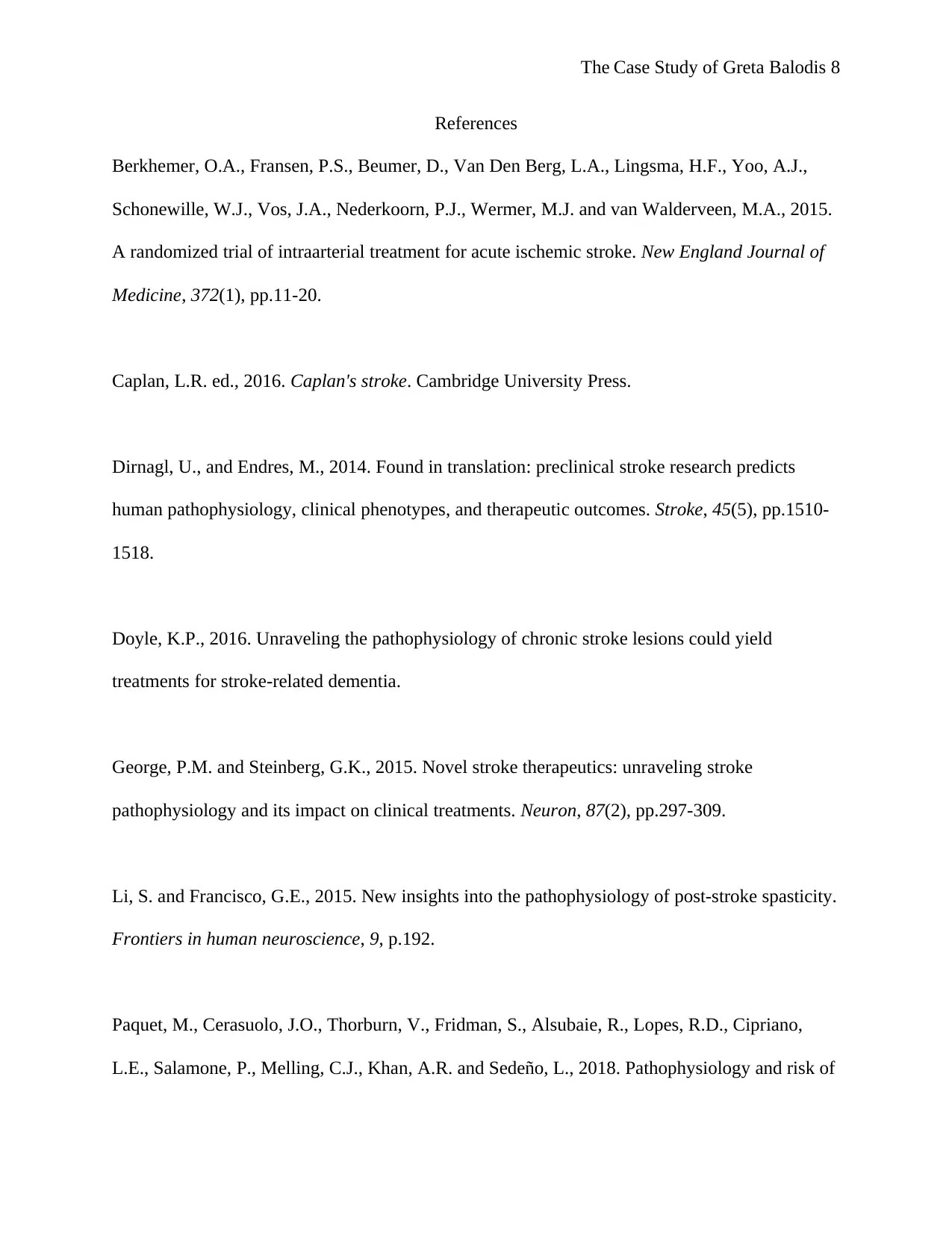
The Case Study of Greta Balodis 8
References
Berkhemer, O.A., Fransen, P.S., Beumer, D., Van Den Berg, L.A., Lingsma, H.F., Yoo, A.J.,
Schonewille, W.J., Vos, J.A., Nederkoorn, P.J., Wermer, M.J. and van Walderveen, M.A., 2015.
A randomized trial of intraarterial treatment for acute ischemic stroke. New England Journal of
Medicine, 372(1), pp.11-20.
Caplan, L.R. ed., 2016. Caplan's stroke. Cambridge University Press.
Dirnagl, U., and Endres, M., 2014. Found in translation: preclinical stroke research predicts
human pathophysiology, clinical phenotypes, and therapeutic outcomes. Stroke, 45(5), pp.1510-
1518.
Doyle, K.P., 2016. Unraveling the pathophysiology of chronic stroke lesions could yield
treatments for stroke-related dementia.
George, P.M. and Steinberg, G.K., 2015. Novel stroke therapeutics: unraveling stroke
pathophysiology and its impact on clinical treatments. Neuron, 87(2), pp.297-309.
Li, S. and Francisco, G.E., 2015. New insights into the pathophysiology of post-stroke spasticity.
Frontiers in human neuroscience, 9, p.192.
Paquet, M., Cerasuolo, J.O., Thorburn, V., Fridman, S., Alsubaie, R., Lopes, R.D., Cipriano,
L.E., Salamone, P., Melling, C.J., Khan, A.R. and Sedeño, L., 2018. Pathophysiology and risk of
References
Berkhemer, O.A., Fransen, P.S., Beumer, D., Van Den Berg, L.A., Lingsma, H.F., Yoo, A.J.,
Schonewille, W.J., Vos, J.A., Nederkoorn, P.J., Wermer, M.J. and van Walderveen, M.A., 2015.
A randomized trial of intraarterial treatment for acute ischemic stroke. New England Journal of
Medicine, 372(1), pp.11-20.
Caplan, L.R. ed., 2016. Caplan's stroke. Cambridge University Press.
Dirnagl, U., and Endres, M., 2014. Found in translation: preclinical stroke research predicts
human pathophysiology, clinical phenotypes, and therapeutic outcomes. Stroke, 45(5), pp.1510-
1518.
Doyle, K.P., 2016. Unraveling the pathophysiology of chronic stroke lesions could yield
treatments for stroke-related dementia.
George, P.M. and Steinberg, G.K., 2015. Novel stroke therapeutics: unraveling stroke
pathophysiology and its impact on clinical treatments. Neuron, 87(2), pp.297-309.
Li, S. and Francisco, G.E., 2015. New insights into the pathophysiology of post-stroke spasticity.
Frontiers in human neuroscience, 9, p.192.
Paquet, M., Cerasuolo, J.O., Thorburn, V., Fridman, S., Alsubaie, R., Lopes, R.D., Cipriano,
L.E., Salamone, P., Melling, C.J., Khan, A.R. and Sedeño, L., 2018. Pathophysiology and risk of
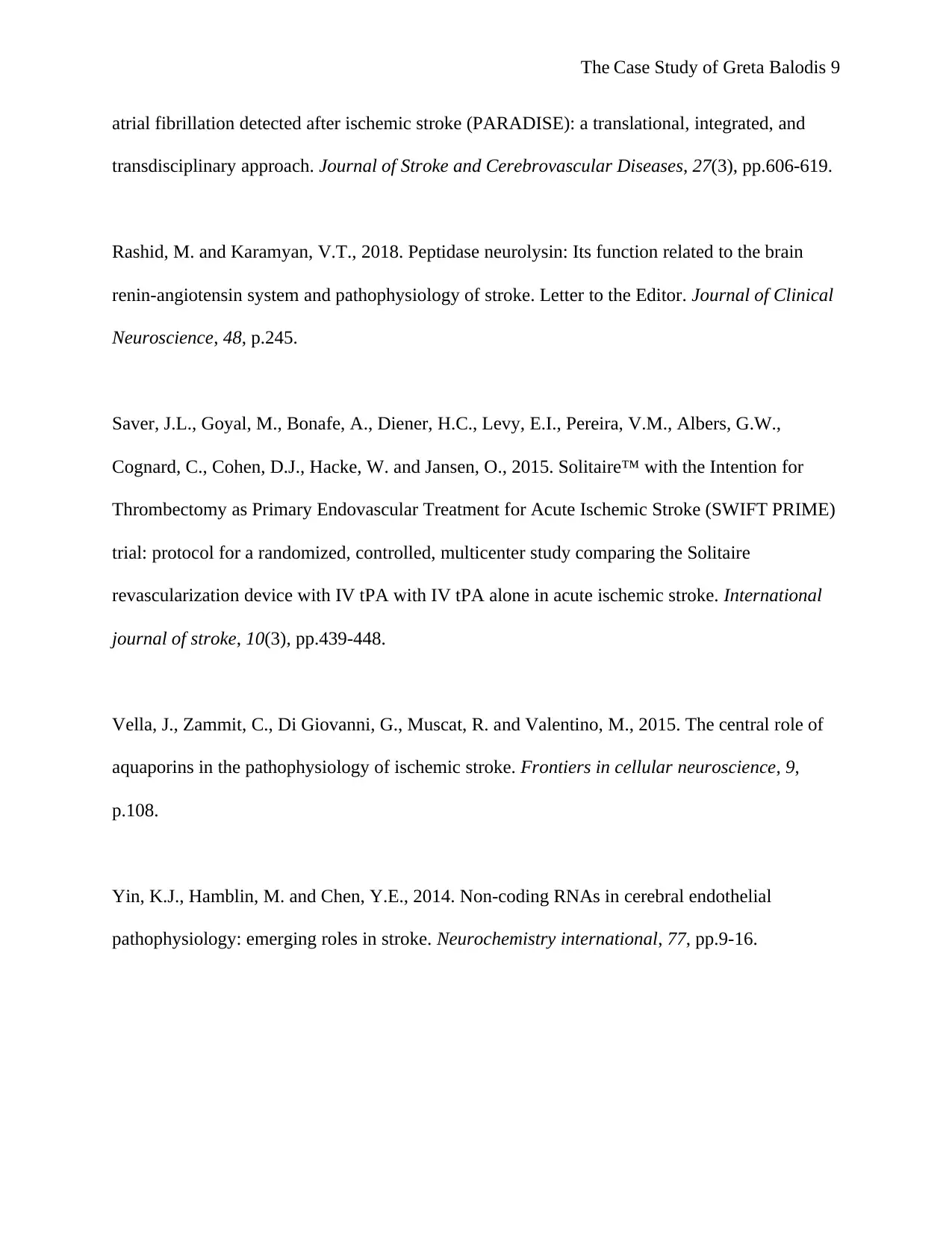
The Case Study of Greta Balodis 9
atrial fibrillation detected after ischemic stroke (PARADISE): a translational, integrated, and
transdisciplinary approach. Journal of Stroke and Cerebrovascular Diseases, 27(3), pp.606-619.
Rashid, M. and Karamyan, V.T., 2018. Peptidase neurolysin: Its function related to the brain
renin-angiotensin system and pathophysiology of stroke. Letter to the Editor. Journal of Clinical
Neuroscience, 48, p.245.
Saver, J.L., Goyal, M., Bonafe, A., Diener, H.C., Levy, E.I., Pereira, V.M., Albers, G.W.,
Cognard, C., Cohen, D.J., Hacke, W. and Jansen, O., 2015. Solitaire™ with the Intention for
Thrombectomy as Primary Endovascular Treatment for Acute Ischemic Stroke (SWIFT PRIME)
trial: protocol for a randomized, controlled, multicenter study comparing the Solitaire
revascularization device with IV tPA with IV tPA alone in acute ischemic stroke. International
journal of stroke, 10(3), pp.439-448.
Vella, J., Zammit, C., Di Giovanni, G., Muscat, R. and Valentino, M., 2015. The central role of
aquaporins in the pathophysiology of ischemic stroke. Frontiers in cellular neuroscience, 9,
p.108.
Yin, K.J., Hamblin, M. and Chen, Y.E., 2014. Non-coding RNAs in cerebral endothelial
pathophysiology: emerging roles in stroke. Neurochemistry international, 77, pp.9-16.
atrial fibrillation detected after ischemic stroke (PARADISE): a translational, integrated, and
transdisciplinary approach. Journal of Stroke and Cerebrovascular Diseases, 27(3), pp.606-619.
Rashid, M. and Karamyan, V.T., 2018. Peptidase neurolysin: Its function related to the brain
renin-angiotensin system and pathophysiology of stroke. Letter to the Editor. Journal of Clinical
Neuroscience, 48, p.245.
Saver, J.L., Goyal, M., Bonafe, A., Diener, H.C., Levy, E.I., Pereira, V.M., Albers, G.W.,
Cognard, C., Cohen, D.J., Hacke, W. and Jansen, O., 2015. Solitaire™ with the Intention for
Thrombectomy as Primary Endovascular Treatment for Acute Ischemic Stroke (SWIFT PRIME)
trial: protocol for a randomized, controlled, multicenter study comparing the Solitaire
revascularization device with IV tPA with IV tPA alone in acute ischemic stroke. International
journal of stroke, 10(3), pp.439-448.
Vella, J., Zammit, C., Di Giovanni, G., Muscat, R. and Valentino, M., 2015. The central role of
aquaporins in the pathophysiology of ischemic stroke. Frontiers in cellular neuroscience, 9,
p.108.
Yin, K.J., Hamblin, M. and Chen, Y.E., 2014. Non-coding RNAs in cerebral endothelial
pathophysiology: emerging roles in stroke. Neurochemistry international, 77, pp.9-16.
⊘ This is a preview!⊘
Do you want full access?
Subscribe today to unlock all pages.

Trusted by 1+ million students worldwide

The Case Study of Greta Balodis 10
Zhang, J.H., 2014. Vascular, neural network in subarachnoid hemorrhage. Translational stroke
research, 5(4), pp.423-428.
Zhang, J.H., 2014. Vascular, neural network in subarachnoid hemorrhage. Translational stroke
research, 5(4), pp.423-428.
1 out of 10
Related Documents
Your All-in-One AI-Powered Toolkit for Academic Success.
+13062052269
info@desklib.com
Available 24*7 on WhatsApp / Email
![[object Object]](/_next/static/media/star-bottom.7253800d.svg)
Unlock your academic potential
Copyright © 2020–2025 A2Z Services. All Rights Reserved. Developed and managed by ZUCOL.




